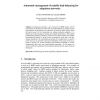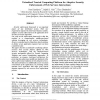897 search results - page 24 / 180 » Security Requirements for RFID Computing Systems |
KDD
1998
ACM
14 years 7 days ago
1998
ACM
The task in the computer security domain of anomaly detection is to characterize the behaviors of a computer user (the `valid', or `normal' user) so that unusual occurre...
APNOMS
2006
Springer
13 years 11 months ago
2006
Springer
In ubiquitous networks, a lot of sensors and RFID readers will be connected to the networks as well as PCs and mobile phones are connected, and huge numbers of transactions are exp...
ICWS
2007
IEEE
13 years 9 months ago
2007
IEEE
Security enforcement framework is an important aspect of any distributed system. With new requirements imposed by SOA-based business models, adaptive security enforcement on the a...
COMPUTER
2004
13 years 7 months ago
2004
After thirty years of work on computer security, why are almost all the systems in service today extremely vulnerable to attack? The main reason is that security is expensive to s...
JCS
2010
13 years 6 months ago
2010
Protocol authentication properties are generally trace-based, meaning that authentication holds for the protocol if authentication holds for individual traces (runs of the protoco...


